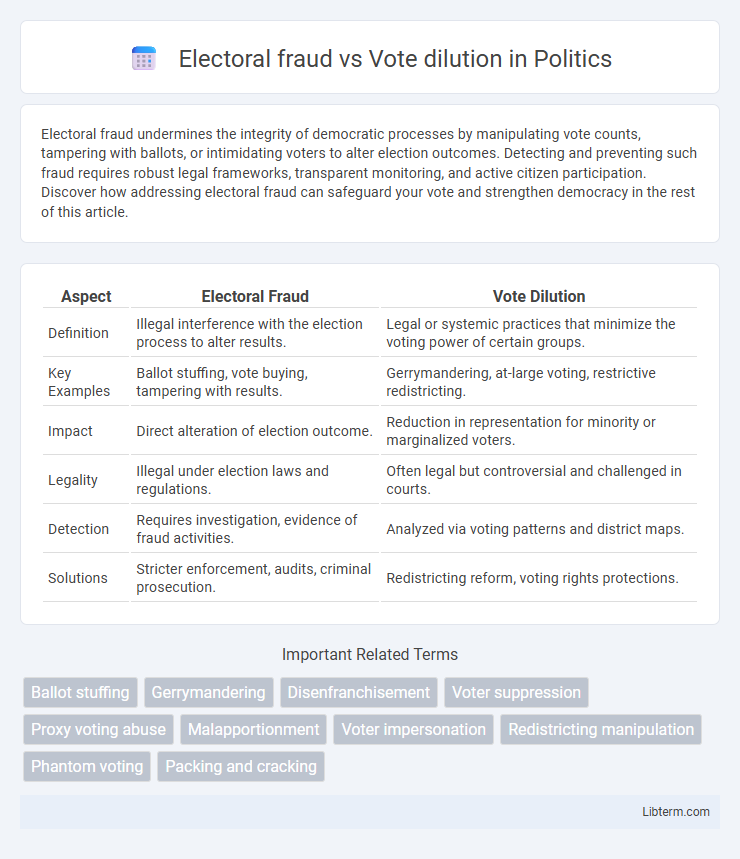Electoral fraud undermines the integrity of democratic processes by manipulating vote counts, tampering with ballots, or intimidating voters to alter election outcomes. Detecting and preventing such fraud requires robust legal frameworks, transparent monitoring, and active citizen participation. Discover how addressing electoral fraud can safeguard your vote and strengthen democracy in the rest of this article.
Table of Comparison
| Aspect | Electoral Fraud | Vote Dilution |
|---|---|---|
| Definition | Illegal interference with the election process to alter results. | Legal or systemic practices that minimize the voting power of certain groups. |
| Key Examples | Ballot stuffing, vote buying, tampering with results. | Gerrymandering, at-large voting, restrictive redistricting. |
| Impact | Direct alteration of election outcome. | Reduction in representation for minority or marginalized voters. |
| Legality | Illegal under election laws and regulations. | Often legal but controversial and challenged in courts. |
| Detection | Requires investigation, evidence of fraud activities. | Analyzed via voting patterns and district maps. |
| Solutions | Stricter enforcement, audits, criminal prosecution. | Redistricting reform, voting rights protections. |
Understanding Electoral Fraud: Definition and Types
Electoral fraud involves illegal interference with the election process, including ballot stuffing, vote buying, and tampering with voting machines, undermining the integrity of democratic elections. Vote dilution, a subtler form of electoral manipulation, occurs when votes are weakened through gerrymandering or discriminatory practices, limiting the influence of certain groups despite legitimate ballots. Understanding these distinctions is crucial for protecting electoral fairness and ensuring that each vote carries equal weight in determining election outcomes.
What is Vote Dilution? Concepts and Mechanisms
Vote dilution refers to practices that weaken the influence of certain voters or groups, often through methods like gerrymandering, at-large voting systems, or vote stacking. These mechanisms reduce the representative weight of targeted populations, effectively minimizing their electoral power without outright invalidating ballots. Unlike electoral fraud, which involves illegal actions such as ballot tampering, vote dilution operates within legal frameworks but undermines democratic equity by skewing political representation.
Key Differences Between Electoral Fraud and Vote Dilution
Electoral fraud involves illegal interference with the election process, such as ballot tampering, vote buying, or miscounting, directly altering election outcomes through illicit actions. Vote dilution refers to legal or structural processes that weaken the influence of certain groups' votes, often through redistricting or at-large elections reducing minority representation without overt fraud. The key difference lies in electoral fraud being deliberate illegal manipulation, while vote dilution occurs through lawful practices impacting electoral fairness and equal representation.
Historical Examples of Electoral Fraud
Electoral fraud involves illegal interference with the election process, such as ballot stuffing, vote buying, and tampering with vote counts, while vote dilution manipulates district boundaries or voter suppression to weaken the impact of certain groups' votes. Historical examples of electoral fraud include the 1876 U.S. presidential election, where disputed returns and voter intimidation led to the controversial Compromise of 1877, and more recent cases like the 2000 Florida recount controversy. These incidents highlight how fraudulent tactics undermine democratic integrity and skew election outcomes.
Historical Instances of Vote Dilution
Historical instances of vote dilution often occurred through practices like gerrymandering, poll taxes, and literacy tests, disproportionately impacting minority voters in the United States, especially African Americans during the Jim Crow era. The Supreme Court case Shelby County v. Holder (2013) highlighted ongoing concerns by invalidating key parts of the Voting Rights Act, which had protected against such dilution. Careful examination of vote dilution reveals systemic barriers that suppress voter influence more subtly than outright electoral fraud, affecting representation in local, state, and federal elections.
Legal Frameworks Addressing Electoral Fraud
Legal frameworks addressing electoral fraud encompass stringent measures such as voter identification laws, election observation protocols, and criminal penalties for vote tampering. Statutes at both national and international levels, including the Electoral Integrity Act and guidelines from the Organization for Security and Co-operation in Europe (OSCE), establish standards to prevent manipulation of ballots and ensure transparency. Enforcement mechanisms and judicial review processes bolster the legitimacy of elections by combating fraud-related offenses and upholding electoral integrity.
Laws and Policies Targeting Vote Dilution
Laws and policies targeting vote dilution primarily aim to prevent practices that weaken the electoral influence of minority groups, such as gerrymandering and at-large elections that disperse voting power. The Voting Rights Act of 1965 plays a crucial role by prohibiting racial discrimination in voting and enforcing district redrawing that ensures fair representation. Courts regularly assess vote dilution claims by examining whether the electoral structure unlawfully diminishes minority voters' ability to elect candidates of choice, balancing electoral fairness and legal standards.
The Impact of Electoral Fraud on Democracy
Electoral fraud undermines the legitimacy of democratic institutions by manipulating vote counts to alter election outcomes, eroding public trust in the electoral process. Vote dilution, a form of electoral fraud, systematically minimizes the influence of specific demographic groups through tactics like gerrymandering and discriminatory voter suppression. The combined effect of these practices weakens representative democracy by skewing political power and disenfranchising citizens.
The Consequences of Vote Dilution for Representation
Vote dilution undermines the principle of equal representation by diminishing the electoral power of specific voter groups, often minorities, leading to skewed legislative outcomes that fail to reflect the electorate's true diversity. This distortion weakens democratic institutions, reduces political accountability, and perpetuates systemic inequalities by marginalizing voices in policy-making processes. In contrast to electoral fraud, vote dilution strategically manipulates district boundaries or voting mechanisms, resulting in long-term disenfranchisement rather than isolated incidents of vote tampering.
Strategies to Prevent Both Electoral Fraud and Vote Dilution
Implementing robust voter identification systems and secure, transparent ballot counting processes effectively combat electoral fraud by ensuring only eligible votes are counted. Enhancing districting practices through independent redistricting commissions prevents vote dilution by creating fair, competitive electoral districts that represent community interests. Investing in voter education and accessible polling locations increases participation and trust, reinforcing protections against both fraud and dilution.
Electoral fraud Infographic

 libterm.com
libterm.com